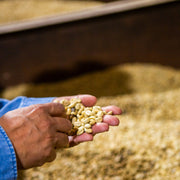We talk about coffee flavor a LOT. But, as it turns out, people drink coffee for other reasons–to wake up in the morning or to help them focus in the afternoon. Who knew? 😉
Disclaimer: We are not medical doctors, and caffeine is a drug that has an impact on your body and your physiology. This blog should not be considered or used as a substitute for medical advice. If you have questions or concerns about your caffeine intake and how it impacts you, you should consult with your doctor.
Today, we will answer some basic caffeine-related questions: How does caffeine increase alertness and make us feel less tired? Why does coffee have caffeine in it, and just how much is there?
Why Is There Caffeine In Coffee?

In short, caffeine keeps the bugs away. Coffee plants are naturally caffeinated! Not just the coffee beans we grind and drink, but everything from the stems to the leaves of the coffee plant contain caffeine. Evolutionarily speaking, it’s pretty ingenious that a plant’s DNA would entail a natural pesticide. Caffeine deters pests from eating the coffee cherries in the same way poisonous animals protect themselves from predators. You can find caffeine in other plants such as tea bushes, cola trees, yerba mate, and cocoa trees.
We know that coffee has been consumed in one form or another since prehistory. People originally ate the fruit or steeped or chewed the leaves and discovered this natural stimulant which led it to being used in Ethiopian coffee ceremonies by the 11th or 12th century.
Given that coffee is poisonous to bugs, you might be wondering if the caffeine in coffee is dangerous for humans to consume? Drink too much, and you can undoubtedly get the jitters (more on that later). But, unless you’re particularly sensitive, caffeine can’t do that much damage. To cause serious physical harm, you’d need to consume around 40 cups of coffee in an hour. So, probably nothing to worry about there…hopefully.
How Much Caffeine Is In A Cup Of Coffee?

The average caffeine content of an 8-ounce cup of coffee is 95 milligrams. A single espresso (1 ounce) has around 60 milligrams.
BUT…There are a LOT of factors that inform this answer. The species and variety of the coffee bean, roast level, brew method, and recipe all play a role in determining how much caffeine is in your brewed coffee. Some factors make a more significant difference than others.
Species And Variety
The robusta species of coffee has significantly more caffeine than arabica beans naturally. This partly explains the more bitter taste of robusta coffee.
Brew Method
Brew method and recipe definitely impact caffeine content. Research has shown that most of the caffeine in coffee is extracted in the first couple of minutes of your brew. But longer contact times do lead to more caffeinated beverages. Methods with shorter brew times, like espresso and most pour-overs, tend to have less caffeine than methods with longer brew times, like a French press or cold brew.
Roast Level
Roast level is often cited as a factor in caffeine content, but this has a lot less impact than the other factors. There is a small amount of caffeine loss as the roast gets darker, but the difference is tiny compared to the factors mentioned above.
Does Caffeine Impact The Flavor Of Coffee?
Caffeine is an alkaloid, and like all alkaloids, it has a bitter flavor. The more caffeine in your drink, the more bitter it becomes. This is why the robusta species of coffee tends to taste pretty bitter. It contains significantly more caffeine than its cousin, arabica. While too much caffeine can taste pretty rough, it is a necessary ingredient to balance out the other flavors. A little sweet, a little fruity, and a little bitter–when properly combined–makes for a deliciously balanced drink.
How Does Caffeine Affect People?

Caffeine makes us feel more alert and can help us focus. A well-timed cup of coffee may even help us hold off sleep to prep for that upcoming test or presentation. But how does it work? We’re not doctors, so please don’t take this as medical advice, but the basics are pretty straightforward.
From the moment you wake up, hormones, neurotransmitters, and other compounds are released in your body. One of these is adenosine. Over time, it finds its way into receptors in your brain that make you start to feel tired and eventually feel the need to sleep. Caffeine acts as a blocker to those receptors. Because it has a similar shape and make-up to adenosine, the caffeine you’ve consumed goes into those same receptors, blocking the adenosine and preventing you from feeling tired. Eventually, though, the caffeine is released from the receptors, and you will start to feel tired again. Or, if you’ve been missing out on too much sleep, you’ll crash quickly. Studies have shown that caffeine also causes the release of adrenaline and dopamine, neurotransmitters that increase brain activity and help you feel more focused.
Can You Become Addicted To Caffeine?

Most doctors will say that, strictly speaking, you cannot become addicted to caffeine. If you’ve grown accustomed to consuming plenty of caffeine, suddenly stopping can cause some physical side effects like grogginess and headaches. But these will usually clear up in about a week’s time. Unless you have specific health concerns, drinking up to four cups of coffee a day is considered by most doctors to be perfectly safe and healthy. So…bottoms up!
So, if coffee is naturally caffeinated, how do you make decaffeinated coffee? Great question! We have a whole blog just about decaf coffee. And we've heard that our decaf, Slow Motion, is the best one out there.
Hopefully, that clears up some of the mysteries around caffeine! Have more questions? Reach out to us on Instagram, Twitter, or Tiktok. Or check out our classes! We hope to grow (and get well-caffeinated) with you soon!







